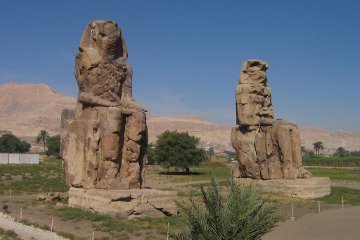Colossal Museum

| |
| The Colossi of Memnon stand guard over a now vanished mortuary temple on the West Bank of the Nile at Luxor. There are plans to make them the centre of an open-air museum. |
One of the sites that is always visited by our tours is the Colossi of Memnon, two huge statues that sit alone in the plain on the west bank of the Nile opposite Luxor.
Of course, they were not always alone, for originally they flanked the entrance to the immense mortuary temple of Amenhotep III, but the temple has almost completely disappeared now; its only visible remains are the Colossi and a stele several hundred feet away that once stood in the rear wall of the temple. Its disappearence is a shame, for if Amenhotep is to be believed, it was once a magnificent structure. Here is his description of it as taken from the stele (and translated by Flinders Petrie):
"Behold, the heart of His Majesty was satisfied with making a very great monument; never has happened the like since the beginning. He made it as his monument for his father Amun - an august temple ... an eternal, everlasting fortress of fine white sandstone, wrought with gold throughout; its floor is adorned with silver, all its portals with electrum; it is made very wide and large, and established for ever ... It is numerous in royal statues, of Elephantine granite, of costly gritstone, of every splendid, costly stone ... Its lake is filled from the great Nile, lord of fish and fowl ... a store-house is filled with male and female slaves, with children of the princes of all the countries of the captivity of His Majesty. Its storehouses contain all good things, whose number is not known. It is surrounded with settlements of Syrians, colonised with children of princes, its cattle are like the sand of the shore; they make up millions."
Recently the sharp-eyed guardians of Egypt's antiquities have noticed that the Colossi are starting to lean. Fearing that they might have a "Leaning Tower of Pisa" on their hands, or even worse that the statues might collapse, the authorities commissioned Rainer Stadelmann, director of the German Institute of Archaeology, to survey the Colossi in 1989. He was able to show that the statues are in no immediate danger.
However, as well as the photogrammatic survey, the diligent professor also examined the foundations upon which the statues were built. These had been uncovered back in 1832 by Garden Wilkinson, but since then a further 10 feet of Nile mud had accumulated. Once this was cleared away Stadelmann discovered, to his surprise, that the statues stood on a foundation of - sand! In fact, the whole temple appears to have been built on sand.
It had been thought that the destruction of the temple may have been brought about by an earthquake, but it is now thought that the annual flooding of the Nile may have been the cause, washing away the sand and causing walls and pylons to buckle and collapse. While subsequent pharaohs may have baulked at robbing a functional temple, none of them saw any problem with taking stone away from a ruin, which may explain why so little remains of this temple when so much is still standing at Medinet Habu or the Ramesseum.
Having made one unexpected discovery, Stadelmann continued his work and recovered a number of broken statues as well as the stone foundations of the pylons and walls of the temple. His workmen, however, were hindered by a thick growth of halfa grass, a nasty weed which is exceptionally fast-spreading. Someone set fire to the grass, probably in an attempt to clear it away and help the work of excavation. Unfortunately, the grass burned so fiercely that the fire actually caused some of the inscribed stonework to split.
Fortunately this disaster has given greater impetus to the work of salvage. Aided by the UN World Monuments Fund, an international mission is now hard at work around the Colossi seeking to uncover and conserve the remains of Amenhotep's glorious temple. In addition a team led by Horst Yaritz of the Swiss Institute of Archaeology is seeking to identify blocks from this temple incorporated into other mortuary temples. It is hoped to set up an open-air museum around the Colossi - which is a shame, as at present access to them is free and the mighty statues, standing alone as they have done for three thousand years, have a presence and a dignity that will be completely ruined when they are surrounded by a tatty white-washed wall, admission 500 lire, photography extra.
Mind you, the advantage of an open-air museum is that the designers will be hard put to achieve the stygian gloom that seems to be the fashion in other modern musea in Egypt and which make a torch an essential accessory to any visit to them (the Luxor and Aswan musea spring particularly to mind). They'll probably do their best by only allowing visitors in at night and then only when the moon is new and the stars obscured by cloud. After all, you wouldn't want the tourists to actually see the things they have paid to look at, would you?
annual flooding This may explain the enormous mud-brick wall which surrounds Medinet Habu, and which some have explained by referring to the collapse of security during the reign of Rameses III. It is true that Egypt grew weaker during this period, but it would be strange if armed bands penetrated to within a few miles of Luxor itself, close enough to threaten the temple, yet ignored all the other temples and tombs half a mile further on. Return





